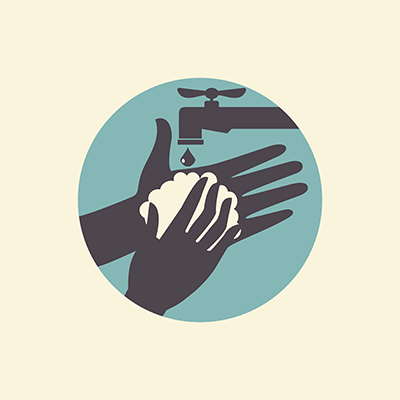
I’m on the train again, which seems to be a theme for writing these blog posts and today as is often the case I am surrounded by people, many of whom seem to have horrendous coughs and colds. These days it’s clearly considered a badge of honour to struggle in to the office with a streaming nose and barking like a seal, as the noise level of these individuals is blocking out the station announcements.
I’m therefore pondering on infection control, given the risk of me leaving this train with a bug I didn’t have when I got on. Infection control is not just for hospitals as we all know, given the huge cross infection issues of communal living. So how do we brush up our technique and make sure service users are assisted to contribute?
Wash your hands
We are reminded all of the time that clean hands are the bedrock of good infection control and we provide hand wash gel now at many public buildings. However, it’s often difficult to manage the risk of having products like these in places where they might be accidentally ingested – or not accidentally, given the interesting habits of some. Ditto with gloves and aprons; a study on infection control in learning disability services back in 2011 highlighted the risks of PPE in the workplace in terms of the service users who might choke, be poisoned or self-harm. In these situations, a cold virus seems a reasonable risk to take!
Washing hands should be second nature to everyone but there are many times I am amazed by the lack of it, for example in public toilets. The fact that a person is in need of full personal care should not remove the need to wash hands after using the loo or being changed. Everything you touch with dirty hands is also likely to be touched by the service user. If they then go off and open and close doors, use equipment, touch other people or need to be manually assisted to mobilise, everything on their hands gets shared. Yet although I rarely see care workers wash the hands of people they have supported in intimate care, it is nonetheless a good habit to encourage.
But DO we wash our hands?
Equally, washing hands before meals is good practice for everyone. Again, observe the routine in your workplace; do people who are assisting someone to eat and drink wash hands before they start? I’m not suggesting we gown up before every episode of care, but simple cleanliness is part of everyday life. You would be amazed how much money is spent on gloves, alcohol wipes, gel, aprons and overshoes but how little actual hand washing goes on in supported living!
The clean hands issue aside, we need to remember how important it is to manage the spread of infection by droplets (meaning of course mucus, saliva and erm, other bodily fluids) Droplet infection through sneezing is the chief way that colds are transmitted. You will no doubt have seen the public health video of an explosive sneeze and how far the resulting product is spread. Encourage the use of paper tissues even with the most profoundly disabled people; if they cannot do this themselves, make sure noses are discreetly cleaned and hands wiped. Work on the habit of covering nose and mouth when sneezing and coughing – where people are not aware of these social norms, we have to help model and instil the behaviour.
Really it’s a question of common sense and application. I hate to deliver a sermon, but the guy next to me just sneezed onto my keyboard, so I’ll close now…….



